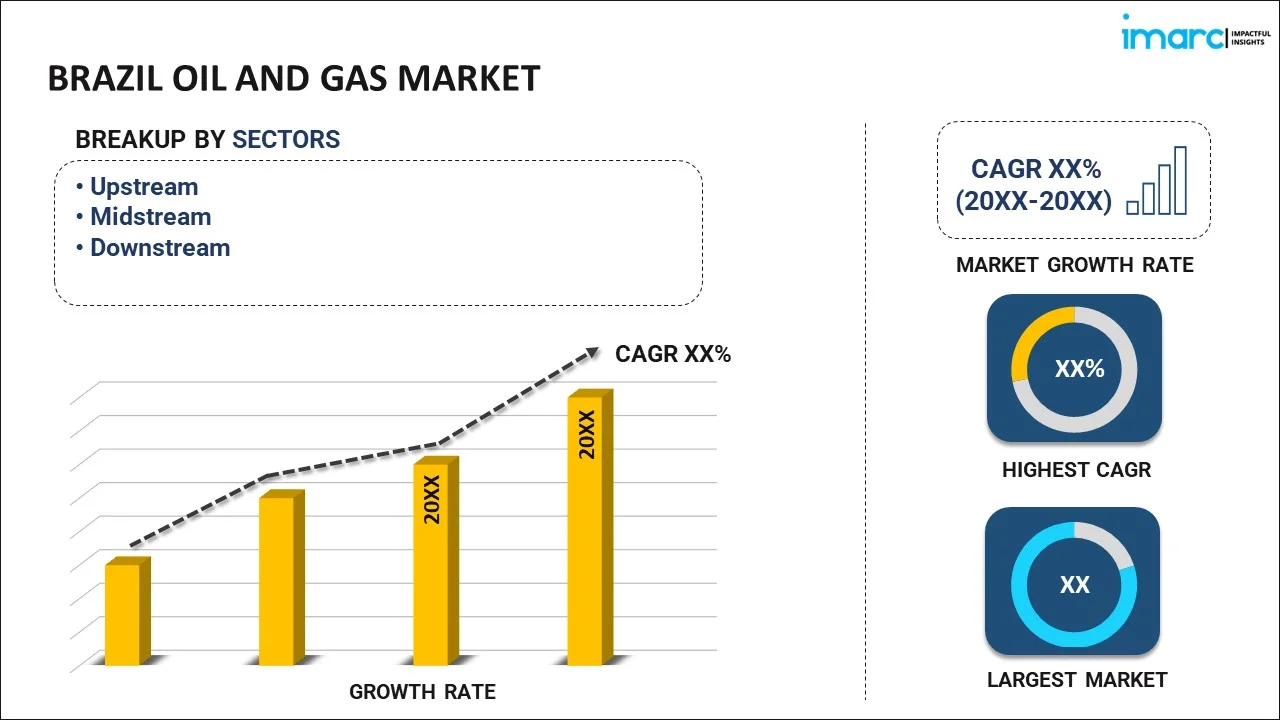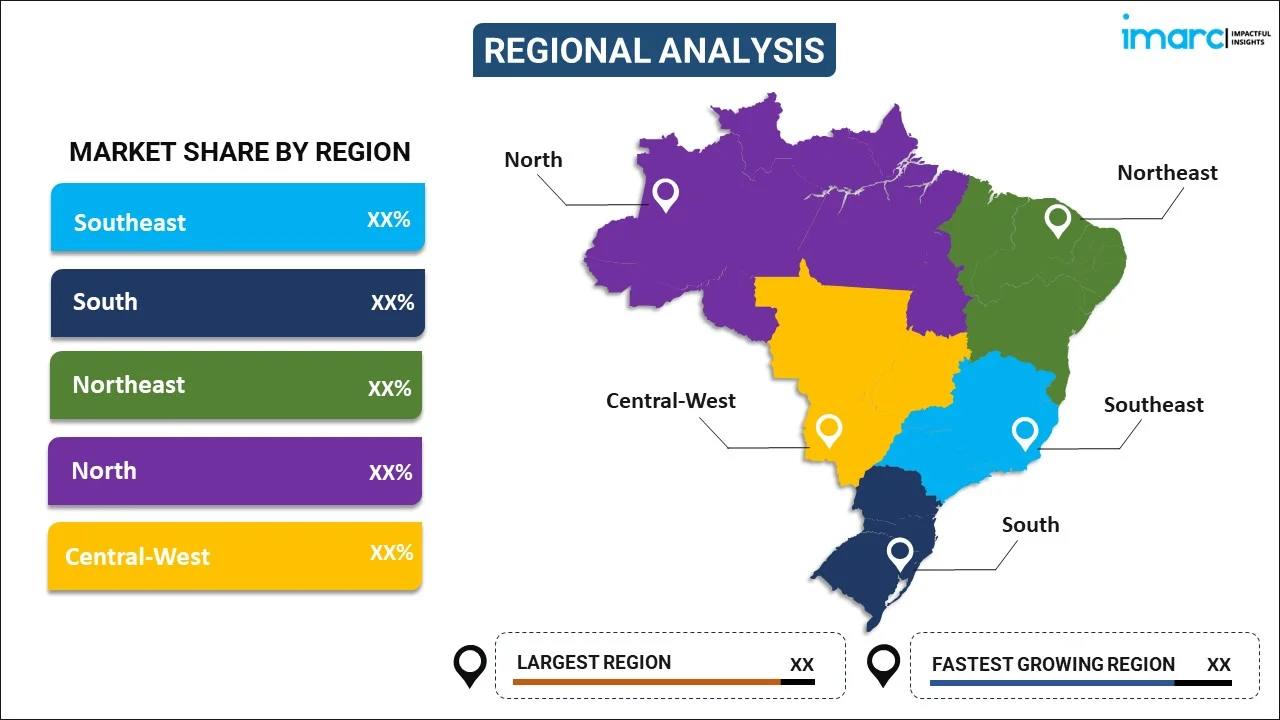
Brazil Oil and Gas Market Report by Sector (Upstream, Midstream, Downstream), and Region 2025-2033
Brazil Oil and Gas Market:
Brazil oil and gas market size is projected to exhibit a growth rate (CAGR) of 3.33% during 2025-2033. The vast offshore oil and gas reserves in the country, favorable government policies and regulatory framework, increasing energy demand, and a commitment to cleaner energy sources represent some of the key factors driving the market.
|
Report Attribute
|
Key Statistics
|
|---|---|
|
Base Year
|
2024 |
|
Forecast Years
|
2025-2033 |
|
Historical Years
|
2019-2024
|
| Market Growth Rate (2025-2033) | 3.33% |
Brazil Oil and Gas Market Analysis:
- Major Market Drivers: The vast offshore oil and gas reserves in the country, particularly in the pre-salt basins, represent one of the key factors driving the market growth. Additionally, supportive government policies and regulatory frameworks are positively influencing the Brazil oil and gas market demand.
- Key Market Trends: The escalating energy demand in Brazil, fueled by its expanding population and industrialization, is proliferating the market's growth. Along with this, the heightened focus on reducing greenhouse gas emissions and addressing climate change has spurred investments in natural gas infrastructure and technologies, thereby contributing to the growth.
- Competitive Landscape: The Brazil oil and gas market analysis report has also provided a comprehensive analysis of the competitive landscape in the market. Also, detailed profiles of all major companies have been provided.
- Geographical Trends: The Southeast region has a strong presence of manufacturing, services, and transportation sectors that rely heavily on energy. Moreover, the South region also exhibits significant demand for oil and gas. This area has a diverse economy with a mix of agriculture, industry, and services. The presence of industries, such as agribusiness and automotive, contributes to a relatively high energy consumption profile.
- Challenges and Opportunities: The aging refinery infrastructure of Brazil, and the rising environmental concerns are hampering the market's growth. However, Brazil is investing in energy diversification, including biofuels, hydropower, and wind energy. This transition can open new opportunities for integrated energy companies and create a more balanced energy portfolio.
Brazil Oil and Gas Market Trends:
Rising Electricity Consumption
As Brazil’s economy expands, electricity consumption is increasing across residential, commercial, and industrial sectors. For instance, according to Statista, Brazil's electricity consumption was expected to reach nearly 519 terawatt-hours in 2023, up around 2% from the previous year. Brazil's energy consumption is predicted to steadily expand over the next decade, hitting 590 terawatt hours by 2027. This heightened demand for electricity drives the need for more energy sources, including oil and gas. These factors further positively influence the Brazil oil and gas market forecast.
Expanding Infrastructure Development
The rising infrastructure development of pipelines plays a critical role in driving the growth in Brazil's oil and gas market. For instance, as of 2019, the country had over 3,100 kilometers of under-construction gas pipelines. Also, in mid-2022, the Energy Research Company (EPE), a division of the Brazilian Ministry of Energy, released the "Transport Gas Pipeline Plan 2022-2026" (PIG). The 2022-26 plan included the construction of five gas pipeline routes, principally to transport gas from the Sergipe and Alagoas basins as well as pre-salt gas. Pipelines offer a cost-effective way to transport large volumes of oil and gas over long distances compared to other methods like road or rail. This reduces overall transportation costs and increases the economic viability of oil and gas projects. These factors are further contributing to the Brazil oil and gas market share.
Increased Deepwater Exploration and Production
The deployment of advanced drilling rigs enables the exploration and development of new oil and gas reserves, particularly in deepwater and pre-salt formations. For instance, Brazil built around 29 offshore rigs and 20 onshore rigs in 2018. With increased activity in the offshore region, particularly in the Campos and Santos basins, the number of rigs and FPSO installations is likely to rise. These rigs are essential for accessing and tapping into Brazil’s extensive offshore resources. These factors are augmenting the Brazil’s oil and gas market growth.
Brazil Oil and Gas Market Segmentation:
IMARC Group provides an analysis of the key trends in each segment of the market, along with forecasts at the country and regional levels for 2025-2033. Our report has categorized the market based on sector.
Breakup by Sector:

- Upstream
- Midstream
- Downstream
The report has provided a detailed breakup and analysis of the market based on the sector. This includes upstream, midstream, and downstream.
According to the Brazil oil and gas market outlook, upstream activities involve the exploration, drilling, and production of crude oil and natural gas. The discovery and development of large offshore reserves, particularly in the pre-salt fields, drive substantial demand for exploration and production services. Brazil’s deepwater and ultra-deepwater oil fields require advanced technologies and significant investment. Moreover, midstream activities involve the transportation, storage, and distribution of crude oil and natural gas. Brazil’s extensive network of pipelines is crucial for transporting oil and gas from production sites to refineries and export terminals. Furthermore, downstream activities involve the refining, distribution, and marketing of refined oil products and natural gas. Demand for refining capacity is driven by the need to process crude oil into various refined products, such as gasoline, diesel, jet fuel, and petrochemicals.
Breakup by Region:

- Southeast
- South
- Northeast
- North
- Central-West
The report has also provided a comprehensive analysis of all the major regional markets, which include Southeast, South, Northeast, North, and Central-West.
According to the Brazil oil and gas market statistics, the Southeast is Brazil’s most economically developed region, encompassing major cities like São Paulo, Rio de Janeiro, and Belo Horizonte. It is the focal point for much of the country's industrial, commercial, and financial activities. Moreover, the North region, including states like Amazonas and Pará, is rich in natural resources but less densely populated. The mining industry, which requires significant energy inputs, drives demand for oil and gas in the region. The remote nature of many areas impacts energy distribution and access, leading to reliance on diesel generators and other decentralized energy solutions.
Competitive Landscape:
The Brazil oil and gas market research report has also provided a comprehensive analysis of the competitive landscape in the market. Competitive analysis such as market structure, key player positioning, top winning strategies, competitive dashboard, and company evaluation quadrant has been covered in the report. Also, detailed profiles of all major companies have been provided.
Brazil Oil and Gas Market News:
- September 2024: Petrobras, Brazil's federal oil firm, unveiled a fresh construction tender for the second refining train at its Abreu e Lima (RNEST) refinery.
- June 2024: Brazil's Batista brothers acquired Fluxus, a company with three natural gas reserves fields, the Tacobo, Tajibo and Yacuiba, in Bolivia's Tarija-Chaco Basin in Brazil.
- June 2024: Brazilian oil and gas company 3R Petroleum Óleo e Gás signed an MOU with PetroReconcavo to share natural gas infrastructure in the Potiguar Basin, part of the Equatorial Margin.
Brazil Oil and Gas Market Report Scope:
| Report Features | Details |
|---|---|
| Base Year of the Analysis | 2024 |
| Historical Period | 2019-2024 |
| Forecast Period | 2025-2033 |
| Units | US$ Million |
| Scope of the Report | Exploration of Historical Trends and Market Outlook, Industry Catalysts and Challenges, Segment-Wise Historical and Predictive Market Assessment:
|
| Sectors Covered | Upstream, Midstream, Downstream |
| Regions Covered | Southeast, South, Northeast, North, Central-West |
| Customization Scope | 10% Free Customization |
| Report Price and Purchase Option | Single User License: US$ 3699 Five User License: US$ 4699 Corporate License: US$ 5699 |
| Post-Sale Analyst Support | 10-12 Weeks |
| Delivery Format | PDF and Excel through Email (We can also provide the editable version of the report in PPT/Word format on special request) |
Key Questions Answered in This Report:
- How has the Brazil oil and gas market performed so far and how will it perform in the coming years?
- What has been the impact of COVID-19 on the Brazil oil and gas market?
- What is the breakup of the Brazil oil and gas market on the basis of sector?
- What are the various stages in the value chain of the Brazil oil and gas market?
- What are the key driving factors and challenges in the Brazil oil and gas?
- What is the structure of the Brazil oil and gas market and who are the key players?
- What is the degree of competition in the Brazil oil and gas market?
Key Benefits for Stakeholders:
- IMARC’s industry report offers a comprehensive quantitative analysis of various market segments, historical and current market trends, market forecasts, and dynamics of the Brazil oil and gas market from 2019-2033.
- The research report provides the latest information on the market drivers, challenges, and opportunities in the Brazil oil and gas market.
- Porter's five forces analysis assists stakeholders in assessing the impact of new entrants, competitive rivalry, supplier power, buyer power, and the threat of substitution. It helps stakeholders to analyze the level of competition within the Brazil oil and gas industry and its attractiveness.
- The competitive landscape allows stakeholders to understand their competitive environment and provides insight into the current positions of key players in the market.
Need more help?
- Speak to our experienced analysts for insights on the current market scenarios.
- Include additional segments and countries to customize the report as per your requirement.
- Gain an unparalleled competitive advantage in your domain by understanding how to utilize the report and positively impacting your operations and revenue.
- For further assistance, please connect with our analysts.
 Inquire Before Buying
Inquire Before Buying
 Speak to an Analyst
Speak to an Analyst
 Request Brochure
Request Brochure
 Request Customization
Request Customization




.webp)




.webp)












